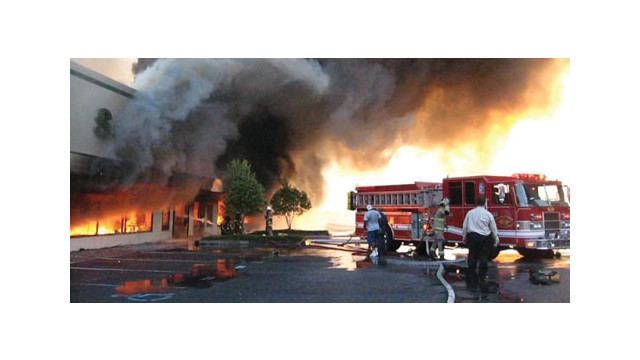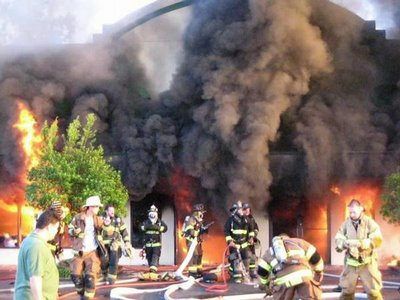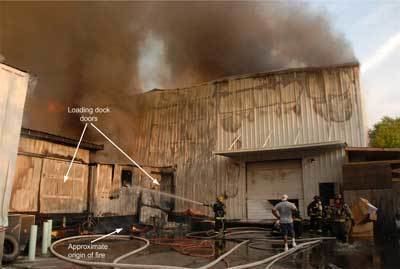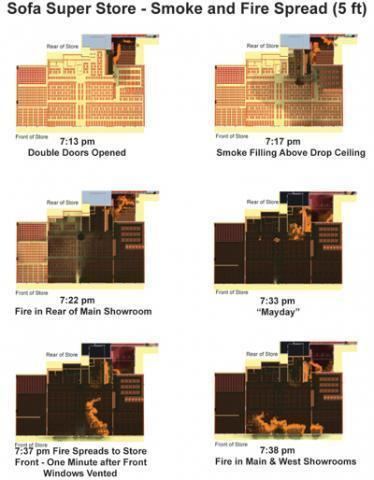Time 7:00 p.m.-4:00 a.m Total number of deaths 9 | Non-fatal injuries 18 Injuries 18 | |
 | ||
Date June 18, 2007 (2007-06-18) to June 19, 2007 (2007-06-19) Cause Discarded cigarette in some discarded furniture on the loading dock Property damage Total loss of building and melted siding on neighbor's house from the heat. Similar Worcester Cold Storage a, The Station nightclub fire, Yarnell Hill Fire | ||
Nist news briefing charleston sofa super store fire
The Charleston Sofa Super Store fire occurred on the evening of June 18, 2007 in Charleston South Carolina, United States and claimed the lives of nine firefighters. This had been the highest number of firefighter fatalities in a single event since the September 11 attacks until June 30, 2013, when nineteen Prescott, Arizona, firefighters from the elite "Granite Mountain Hotshots" team died at the Yarnell Hill Wildfire. The fire was believed to have started in some discarded furniture in the loading dock area, and though the source of ignition has been left undetermined, there is reason to believe that it may have been a discarded cigarette.
Contents
- Nist news briefing charleston sofa super store fire
- Fire and collapse
- Timeline
- Investigations
- Charleston panel
- SLED inquiry
- Criticism
- Memorials
- Gallery
- References

Fire and collapse

The fire occurred at the Sofa Super Store, composed of a 42,000 ft² (3,902 m²) single-story steel trussed showroom building with a 17,000 ft² (1,579 m²) warehouse building located behind the retail space, located at 1807 Savannah Highway in Charleston. The building had no fire sprinkler system. The fire started at approximately 7:00 p.m. in a covered loading dock area built between the showroom and warehouse buildings which was attached to both buildings. At the time, the business was open and employees were present. Charleston firefighters arrived on the scene within three minutes of the alarm, followed soon after by firefighters from the St. Andrews Public Service District.
The initial attack focused on extinguishing the fire in the loading dock area, with a secondary effort to search for and evacuate people inside, and prevent the fire from spreading to the showroom and warehouse. Crews entering the showroom reportedly initially encountered clear visibility with only very light puffs of smoke visible near the ceiling at the back of the showroom. Shortly thereafter, an exterior door was opened near where the fire was raging. Efforts to close the door failed, allowing the fire to enter the showroom. Firefighters were ordered to stretch two hose lines into the showroom to attack the spreading fire; however, the pre-connected hose line from one of the units was too short. This required some firefighters to again exit the building to add additional sections of hose, and left only one small handline to hold back the growing fire. At about this time, fire dispatchers advised the crews on-scene that they had received a 9-1-1 call from an employee who was trapped in the warehouse, which required some firefighters to direct their attention to the rescue. The trapped employee was eventually rescued by firefighters who breached an exterior wall to reach him.

Despite efforts to confine and extinguish the fire, it continued to spread into the structure and ignited furniture in the showroom, growing more quickly than the few operating hose lines could control. Meanwhile efforts to stretch and begin operating additional hose lines continued. At 7:41 p.m. the showroom area of the store experienced a flashover while at least sixteen firefighters were working inside. The flashover contributed to the rapid deterioration of the structural integrity of the building, leading to a near-complete collapse of the roof minutes later. Many of the firefighters caught in the flashover were unable to escape and were trapped under the collapsed roof and shelving weakened by the fast-spreading fire. Several calls for help were made by trapped firefighters and efforts to rescue them were commenced. These efforts proved unsuccessful. By the time the fire was brought under control, nine Charleston firefighters had been killed.

The Sofa Super Store site was on a major business and commuter artery feeding the suburbs and shopping centers of Charleston. Car traffic continued unabated for many critical minutes in the initial stages of the fire, driving over water supply lines and contributing to severe water supply problems, as the supply lines snaked from hydrants in surrounding blocks up to a half-mile away from the center of the fire. Eventually automobile traffic on Savannah Highway was stopped so that water pressure would be more consistent, the traffic diversion causing surrounding neighborhoods to fill with stranded commuters and onlookers. As the fire diminished and appeared contained, nearing 11:00 PM, surrounding neighborhoods began to clear and onlookers departed, most unaware of the loss of life during the blaze.

According to Charleston County Coroner Rae Wooten, the firefighters died of a combination of smoke inhalation and burns, but not from injuries sustained from the collapse itself. It was the greatest single loss of firefighters in the United States since 343 firefighters were killed in the collapse of the World Trade Center in the September 11, 2001 attacks. It was also the deadliest fire in the state of South Carolina since a fire that killed 11 people at the Lancaster County jail in 1979.
Timeline
Investigations
About fifty investigators in all were assigned to the investigation, including the City of Charleston Police Department, the Charleston County Sheriff's Office, the South Carolina State Law Enforcement Division, and the ATF national response team. The ATF confirmed on June 23 that the fire originated in the covered loading dock area situated between the showroom and warehouse buildings, in a pile of trash near an area where employees were known to take smoking breaks. Neither of the destroyed buildings had sprinklers, nor were they required by local codes to have them.
The South Carolina Department of Labor, Licensing and Regulation will investigate the Charleston Fire Department's procedures and training in light of the deaths. The National Institute for Occupational Safety and Health (NIOSH), as always when a firefighter line-of-duty-death occurs, is expected to conduct an independent investigation of the incident. The National Institute of Standards and Technology (NIST) assisted NIOSH by reconstructing the fire with a computer simulation.
On Monday, July 2, 2007, Chief Rusty Thomas told the CDC (which oversees NIOSH, the federal department that investigates firefighter fatalities) that his department would not allow federal investigators to interview firefighters about the Sofa Super Store fire. On Tuesday, July 3, 2007, the head of NIOSH wrote to Chief Thomas, asking him to reconsider. On Thursday, July 5, 2007, the city relented when Mayor Joe Riley called the CDC to say that interviews would be allowed. CDC spokesman Fred Blosser, in an interview with MSNBC said, "This is a developing situation. This morning we were notified that the chief has said that he will grant access to the firefighters. Earlier this week, he had indicated that he was denying access to the firefighters for interviews." Mayor Riley replied that it was all a misunderstanding. He said that Chief Thomas was merely trying to minimize the number of interviews of his weary and grieving firefighters, not to block any investigation.
The U.S. Fire Administration also investigated the fire, to incorporate lessons into the curriculum at the National Fire Academy.
Charleston panel
A panel of outside experts was convened by the City of Charleston to examine the city's fire department and its handling of the fire. The panel included Gordon Routley, Kevin Roche, Tim Sendelbach, Brian Crawford, Mike Chiramonte, and Pete Piringer. Mayor Joe Riley stated that the panel's work was divided into three parts. The team's first step was to conduct an "intense diagnostic analysis" of the fire department and its practices and procedures. The mayor indicated this phase would only take about a month, and any recommendations will be acted on immediately. The second step would compile reports from local, state, and federal investigators into one report the city could work from, to last approximately four months. The last step was to create a long term strategic plan to chart a future course for the city's fire department.
Brian Crawford, in an interview with KTBS-TV News said, "That report is going to lend so much information to other fire departments across the country who may be operating the same way that Charleston was. It may have them step back and look at their own organizations."
The six person panel came out with a list of initial recommendations in less than a week. Speaking of the recommended changes, Gordon Routley said, "I think there are areas that are significant firefighter safety issues that, to us, need to be implemented as soon as possible."
The initial changes recommended by the panel include:
SLED inquiry
In early 2010, Charleston area solicitor Scarlett Wilson requested a SLED (South Carolina Law Enforcement Division) inquiry into the fire to determine if criminal charges should be pursued. After an initial inquiry, SLED returned a statement that the fire "does not meet the criteria for a SLED criminal investigation."
Criticism
The City of Charleston refused help from the International Association of Fire Fighters (IAFF) and International Association of Fire Chiefs (IAFC) in planning the memorial, which exacerbated tensions between the IAFF and South Carolina Firefighters' Association (SCFA). The IAFF's General President Harold Schaitberger has charged that Mayor Joseph Riley and Fire Chief Rusty Thomas are not "labor friendly" and that Charleston is an "openly anti-union city".
The International Association of Fire Fighters (IAFF) and other fire safety experts, including Roger L. Yow, president of the Charleston Firefighters Association and a former captain with 25 years of service in the department, have been critical of the manner in which the fire was handled. Union officials and other fire safety experts claim the City of Charleston Fire Department did not follow procedures consistent with the National Incident Management System. South Carolina governor Mark Sanford directed all state and local emergency response agencies to adopt the system in 2005. Acting state fire marshal John Reich said the state does not inspect the operating procedures of fire departments, but they assume that departments are following guidelines prescribed in the National Incident Management System. Some fire safety experts have also questioned why so many firefighters were in a burning building with a steel truss roof, which is known to be a serious safety hazard for firefighters. A routine fire preplan of the structure in June 2006 made no mention of its roof construction, and it has been suggested that CFD firefighters did not pull the ceiling to check for extension into the roof structure.
In a telephone interview with The Charlotte Observer, Charleston Mayor Joe Riley responded to critics by saying, "I have absolute confidence in our procedures and in the leadership." Chief Thomas and some firefighters with the City of Charleston dismiss critics as outsiders who don't understand the realities of fighting fires in a dense city full of historic buildings. The Post and Courier has quoted Chief Thomas as saying "Our firefighting techniques are not going to change in the City of Charleston Fire Department [...] We're safe, we've got the best equipment, we've got the best people and that's the way we fight fires." Chief Thomas has indicated that his men performed just as they were trained, and he wouldn't do anything differently if the same fire happened again. Greg Hambrick, reporting for the Charleston City Paper questioned the chief's reply. "It was an odd response considering a very hush-hush investigation is ongoing and Riley had said several times since the fire that lessons would be learned. Considering nine guys walked into the fire and didn't come out, there must be something that could protect our firefighters next time." Charleston mayoral candidate Dudley Gregorie, referring to the incident, said "To keep doing things the same way, and expecting different results, is insanity."
Some fire experts have questioned why the exterior front windows were taken out by firefighters while crews were committed inside, an action that could have increased the amount of oxygen being fed to the fire and drawn flames to the front of the store. Assistant Fire Chief Larry Garvin stated that fire blew out the windows, at which time firefighters broke open more windows to allow firefighters to escape.
Questions were also raised about the Charleston Fire Department's use of booster lines to fight the fire. Booster lines are only 1 inch (25 mm) in diameter, and deliver only 30 US gallons (110 l; 25 imp gal) to 60 US gallons (230 l; 50 imp gal) of water per minute, much less than a standard 1.75-inch (44 mm) attack line, which delivers up to 150 US gallons (570 l; 120 imp gal) of water per minute, approximately 150% more than a booster line. The smaller booster lines are less effective against very large fires, and offer less protection to firefighters when flames get out of control. Chief Thomas has said that he doesn't know who pulled the booster lines that could be seen in photographs and videos of the fire, but he doubts that they extended more than 15 feet (5 m) inside the structure, and he insists none were used to fight the fire inside.
Analysis of photographs and video also raised concerns about firefighters, including chief officers, who were not utilizing personal protective equipment appropriately. Some firefighters were wearing street clothes, while others had open coats or were missing helmets. Some firefighters could be seen walking through toxic smoke without air packs. Fire Chief Rusty Thomas has indicated that everyone inside the structure, including the nine fallen firefighters, were wearing the appropriate protective equipment.
Although thermal imaging cameras were available on the scene, they were not used in the scene size-up or to help find victims.
Memorials
A public memorial service for the fallen firefighters took place on Friday, June 22, 2007 at the North Charleston Coliseum in North Charleston. A procession of more than 300 fire engines, ladder trucks, ambulances, and command vehicles which stretched approximately 7.5 miles (12 km) long moved single file along a route which passed each of the three fire stations from which firefighters were lost as well as past the site of the fatal fire, while some bystanders, police officers, and ATF agents paid their respects by saluting or holding their hands over their hearts. The procession then moved along Interstate 526 to the North Charleston Coliseum. An estimated 30,000 people, including as many as 8,000 firefighters representing over 700 emergency services agencies from around the country attended the gathering.
The largest of several funds established for the families of the fallen firefighters raised nearly $1.2 million to benefit the families of the fallen firefighters. This figure does not include an additional $100,000 donated by the Leary Firefighters Foundation, nor several other funds established since the incident. In addition, Sofa Super Store owner Herb Goldstein established the Charleston Nine Scholarship Endowment with a startup donation of $100,000, which will help defray the costs of college tuition for first responders and to children or dependents of both first responders currently serving and those who have lost their lives in the line of duty. Other shops and businesses around the city also accepted donations or contributed a portion of their sales towards the families of the fallen firefighters.
Numerous firefighters from the area accepted an offer from a local tattoo parlor, which employed a St. Andrews firefighter who escaped the collapse, to receive a free tattoo memorializing the lost Charleston firefighters. Firefighters were invited to choose from several memorial designs created specifically as remembrances of the lost firefighters.
Mayor Joe Riley announced on June 27, 2007, that the City of Charleston had reached a tentative agreement with Sofa Super Store owner Herb Goldstein to turn the site of the tragedy into a park with a memorial for the nine fallen firefighters. The following day, Riley proposed a second memorial be included in a planned, but controversial, county park. "It could be where every firefighter in the region goes for their picnic," Riley said. The second memorial has been criticized as a move to garner support for the county park project.
On March 25, 2008, it was announced that South Carolina state lawmakers had approved a bill to name a 3.6 mile stretch of U.S. Route 17 in honor of the fallen Charleston firefighters. The designated section, to be named the "Charleston Nine Memorial Highway", runs from the intersection with S.C. Highway 171 to Sam Rittenberg Boulevard and includes the site of the fire.
The Summerville High School basketball team, of which Captain Louis Mulkey was an assistant coach, was presented with a custom memorial fire helmet by the Charleston Fire Department. The team placed the helmet on the bench for each of the team's games in the 2007–08 season. Summerville went on to win its first-ever state basketball championship.
In 2008, the Coastal Carolina Council of the Boy Scouts of America sold a patch that commemorated the Charleston Nine.
Gallery
The following images show what the Sofa Super Store looked like the day after the fire.
The following are images of the memorial placed along the sidewalk in front of the Sofa Super Store.
